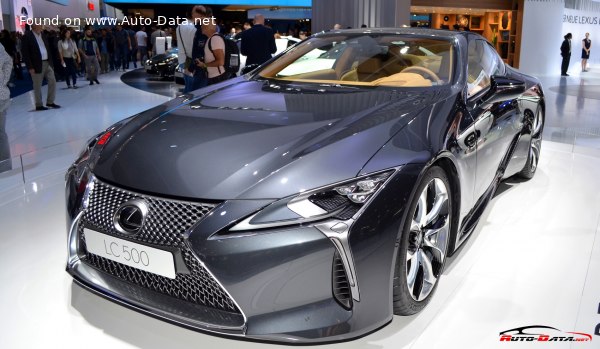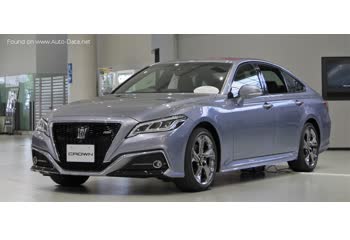Lexus LC LC 2019 - 500h V6 (359 Hp) Hybrid Multistage specifications
Overview
What is the engine capacity of a Lexus LC 2019?
The engine capacity of the Lexus LC 2019 is 3456 cm.
Lexus LC 2019 How many horsepower?
The engine power of the Lexus LC 2019 is 299 Hp @ 6600 rpm..
What is the Lexus LC 2019 engine?
Lexus LC 2019 engine is 8GR-FXS. (Click to see other cars using the same engine)
How powerful is the electrical system in the Lexus LC 2019?
The power of the electrical system in the Lexus LC 2019 is 359 Hp hp.
How much gasoline does a Lexus LC 2019 consume?
The Lexus LC 2019 consumes 6.6 liters of gasoline per 100 km
What is the recommended oil for a Lexus LC 2019 engine?
The recommended oil for a Lexus LC 2019 car engine is 0W-20.
What type of camshaft transmission system is used in a Lexus LC 2019 engine?
chain is used to transmit motion.
General:
Brand
Lexus
Model
LC
Generation
LC
Modification (Engine)
500h V6 (359 Hp) Hybrid Multistage
Start of production
June, 2019
End of production
Powertrain Architecture
FHEV (Full Hybrid Electric Vehicle)
Body type
Seats
4
Doors
2
Engine:
Engine systems
Start & Stop System
Power
299 hp @ 6600 rpm.
Power per litre
86.5 hp/l
Torque
350 nm @ 5100 rpm.
Engine Model/Code
Engine displacement
3456 cm
Number of cylinders
6
Engine configuration
V-engine
Number of valves per cylinder
4
Fuel injection system
Direct injection and Multi-port manifold injection
Engine aspiration
Naturally aspirated engine
Engine oil capacity
5.7 l
Coolant
10.9 l
Engine layout
Front, Longitudinal
Cylinder Bore
94 mm
Piston Stroke
83 mm
recommended engine oil
0W-20
euro standards
EURO 6
engine lifespan (km)
~300 000
timing drive
chain
Show more details about this engine
Performance:
Fuel Type
Petrol (Gasoline)
Fuel consumption (economy) - urban
7.4 l/100 km
Fuel consumption (economy) - extra urban
6 l/100 km
Fuel consumption (economy) - urban (NEDC, WLTP equivalent)
7.4 l/100 km
Fuel consumption (economy) - extra urban (NEDC, WLTP equivalent)
6 l/100 km
Fuel consumption (economy) - combined (NEDC, WLTP equivalent)
6.6 l/100 km
Fuel consumption (economy) - combined
6.6 l/100 km
Emission standard
Euro 6d-TEMP-EVAP-ISC
Acceleration 0 - 100 km/h
5.0 sec
Acceleration 0 - 62 mph
5.0 sec
Maximum speed
250 km/h, Electronically limited
Weight-to-power ratio
5.3 kg/Hp, 188 Hp/tonne
Weight-to-torque ratio
5.5 kg/Nm, 183.2 Nm/tonne
Acceleration 0 - 60 mph
4.8 sec
Electric system:
Gross battery capacity
1.1 kWh
Battery technology
Lithium-ion (Li-Ion)
Battery location
Behind the back wall of the passenger cabin
System power
359 hp
Electric motor power
179 hp
Electric motor Torque
300 nm
Electric motor type
Synchronous
Battery voltage
311 V
Size and space:
Kerb Weight
1910-1945 kg
Max. weight
2445 kg
Max load
500-535 kg
Trunk (boot) space - minimum
172 l
Fuel tank capacity
84 l
Dimensions:
Length
4770 mm
Width
1920 mm
Height
1345 mm
Wheelbase
2870 mm
Width including mirrors
2168 mm
Front track
1630 mm
Rear (Back) track
1635 mm
Front overhang
930 mm
Rear overhang
970 mm
Power transmission system, suspension and brake system:
Drivetrain Architecture
The Internal combustion engine (ICE) and electric motor drive the rear wheels of the car with the ability to work in full electric or mixed mode.
Drive wheel
Rear wheel drive
Number of gears and type of gearbox
automatic transmission Multistage Hybrid
Front brakes
Ventilated discs
Rear brakes
Ventilated discs
Assisting systems
ABS (Anti-lock braking system)
Steering type
Steering rack and pinion
Power steering
Electric Steering
Tires size
Front wheel tires: 245/45 R20Y
Wheel rims size
Front wheel rims: 8.5J x 20
Front suspension
Independent multi-link suspension
Rear suspension
Independent multi-link suspension





